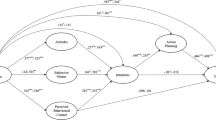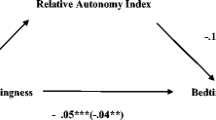Abstract
The aim of the study was to test the motivation and awareness variables of the I-change model as predictors of adolescent intention to go to bed earlier. Questionnaires regarding sleep related motivational and awareness variables were administered to 127 sleep restricted (determined by actigraphy) high school students (12–17 years old). The motivational variables positive attitudes towards sleep and parents setting wake time predicted higher intentions to go bed earlier. The awareness variable sleep related cues to action also predicted higher intentions to advance bedtime. Positive attitudes towards sleep partially mediated the effect of sleep related cues to action on intention to advance bedtime. Future sleep promotion programs should train adolescents to detect cues to go to bed earlier to increase their intentions to go to bed earlier. Adolescents should be assisted to develop positive attitudes towards sleep as to enhance their autonomous motivation to advance their bedtime.


Similar content being viewed by others
References
Ajzen, I. (1991). The theory of planned behavior. Organizational Behavior and Human Decision Processes, 50(2), 179–211.
Ajzen, I., & Madden, T. J. (1986). Prediction of goal-directed behavior: Attitudes, intentions, and perceived behavioral control. Journal of Experimental Social Psychology, 22(5), 453–474.
Araújo-Soares, V., McIntyre, T., & Sniehotta, F. F. (2009). Predicting changes in physical activity among adolescents: the role of self-efficacy, intention, action planning and coping planning. Health Education Research, 24(1), 128–139.
Baker, C. W., Little, T. D., & Brownell, K. D. (2003). Predicting adolescent eating and activity behaviors: the role of social norms and personal agency. Health Psychology, 22(2), 189–198.
Bakotić, M., Radošević-Vidaček, B., & Košćec, A. (2009). Educating adolescents about healthy sleep: Experimental study of effectiveness of educational leaflet. Croatian Medical Journal, 50(2), 174–181.
Bandura, A. (1986). Social foundations of thought and action: A social cognitive theory. Englewood Cliffs, NJ: Prentice-Hall.
Bandura, A. (2006). Adolescent development from an agentic perspective. In F. Pajares & T. Urdan (Eds.), Self-efficacy beliefs of adolescents (Vol. 5, pp. 1–43).
Britton, W. B., Bootzin, R. R., Cousins, J. C., Hasler, B. P., Peck, T., & Shapiro, S. L. (2010). The contribution of mindfulness practice to a multicomponent behavioral sleep intervention following substance abuse treatment in adolescents: a treatment-development study. Substance Abuse, 31(2), 86–97.
Cain, N. (2012). Ready, willing, and able? Sleep hygiene education, motivational interviewing and cognitive behavior therapy for insomnia in an Australian high school setting. Education and Health, 30(3), 60–63.
Cain, N., Gradisar, M., & Moseley, L. (2011). A motivational school-based intervention for adolescent sleep problems. Sleep Medicine, 12(3), 246–251.
Calamaro, C., Mason, T., & Ratcliffe, S. (2009). Adolescents living the 24/7 lifestyle: effects of caffeine and technology on sleep duration and daytime functioning. Pediatrics, 123(6), e1005.
Carskadon, M. (2011). Sleep in adolescents: the perfect storm. Pediatric Clinics of North America, 58(3), 637–647.
Carskadon, M., Harvey, K., Duke, P., Anders, T., Litt, I., & Dement, W. (1980). Pubertal changes in daytime sleepiness. Sleep, 2(4), 453–460.
Carskadon, M., Vieira, C., & Acebo, C. (1993). Association between puberty and delayed phase preference. Sleep, 16, 258–258.
Carskadon, M., Harvey, K., Duke, P., Anders, T. F., Litt, I. F., & Dement, W. C. (2002). Pubertal changes in daytime sleepiness. Sleep, 25(6), 525–605.
Cassoff, J., Knäuper, B., Michaelsen, S., & Gruber, R. (2013). School-based sleep promotion programs: Effectiveness, feasibility and insights for future research. Sleep Medicine Reviews, 17(3), 207–214.
Cortesi, F., Giannotti, F., Sebastiani, T., Bruni, O., & Ottaviano, S. (2004). Knowledge of sleep in Italian high school students: pilot-test of a school-based sleep educational program. Journal of Adolescent Health, 34(4), 344–351.
Dahl, R. E. (1999). The consequences of insufficient sleep for adolescents: Links between sleep and emotional regulation. Phi Delta Kappan, 80.
De Vries, H., Backbier, E., Kok, G., & Dijkstra, M. (1995). The impact of social influences in the context of attitude, self efficacy, intention, and previous behavior as predictors of smoking onset. Journal of Applied Social Psychology, 25(3), 237–257.
De Vries, H., Dijkstra, M., & Kuhlman, P. (1988). Self-efficacy: the third factor besides attitude and subjective norm as a predictor of behavioral intentions. Health Education Research, 3(3), 273–282.
De Vries, H., Mesters, I., Van’t Riet, J., Willems, K., & Reubsaet, A. (2006). Motives of Belgian adolescents for using sunscreen: the role of action plans. Cancer Epidemiology Biomarkers & Prevention, 15(7), 1360–1366.
De Vries, H., & Mudde, A. N. (1998). Predicting stage transitions for smoking cessation applying the attitude-social influence-efficacy model. Psychology & Health, 13(2), 369–385.
Deci, E. L., Vallerand, R. J., Pelletier, L. G., & Ryan, R. M. (1991). Motivation and education: The self-determination perspective. Educational Psychologist, 26(3–4), 325–346.
Elder, J. P., Ayala, G. X., & Harris, S. (1999). Theories and intervention approaches to health-behavior change in primary care. American Journal of Preventive Medicine, 17(4), 275–284.
Evans, R. I., Rozelle, R. M., Mittelmark, M. B., Hansen, W. B., Bane, A. L., & Havis, J. (1978). Deterring the onset of smoking in children: Knowledge of immediate physiological effects and coping with peer pressure, media pressure, and parent modeling. Journal of Applied Social Psychology, 8(2), 126–135.
Fishbein, M., & Ajzen, I. (1975). Belief, attitude, intention and behavior: An introduction to theory and research. Reading. MA: Addison-Wesley.
Graham, D. J., Sirard, J. R., & Neumark-Sztainer, D. (2011). Adolescents’ attitudes toward sports, exercise, and fitness predict physical activity 5 and 10years later. Preventive Medicine, 52(2), 130–132.
Groenland, E., & Stalpers, J. (2012). Structural Equation Modeling: A Verbal Approach. Nyenrode Research Paper (12–02).
Gruber, R., Wiebe, S. T., Wells, S., Cassoff, J., & Monson, E. (2010). Sleep and academic success: mechanisms, empirical evidence, and interventional strategies. Adolescent Medicine: State of the Art Reviews, 21(3), 522–541.
Holm, K., Kremers, S. P. J., & De Vries, H. (2003). Why do Danish adolescents take up smoking? The European Journal of Public Health, 13(1), 67–74.
Hoyle, R. H., & Panter, A. T. (1995). Writing about structural equation models. In R. H. Hoyle (Ed.), Structural equation modeling, concepts, issues, and applications (pp. 158–176). Thousand Oaks, CA: Sage Publications.
Hu, L., & Bentler, P. M. (1999). Cutoff criteria for fit indexes in covariance structure analysis: Conventional criteria versus new alternatives. Structural Equation Modeling: A Multidisciplinary Journal, 6(1), 1–55.
Janz, N. K., & Becker, M. H. (1984). The health belief model: a decade later. Health Education & Behavior, 11(1), 1–47.
Kahn, J. A., Goodman, E., Slap, G. B., Huang, B., & Emans, S. J. (2001). Intention to return for papanicolaou smears in adolescent girls and young women. Pediatrics, 108(2), 333–341.
LaBrie, J. W., Quinlan, T., Schiffman, J. E., & Earleywine, M. E. (2005). Performance of alcohol and safer sex change rulers compared with readiness to change questionnaires. Psychology of Addictive Behaviors, 19(1), 112–115.
Lajunen, T., & Räsänen, M. (2004). Can social psychological models be used to promote bicycle helmet use among teenagers? A comparison of the Health Belief Model, Theory of Planned Behavior and the Locus of Control. Journal of Safety Research, 35(1), 115–123.
Littner, M., Kushida, C., Bailey, D., Berry, R. B., Davila, D. G., & Hirshkowitz, M. (2003). Practice parameters for the role of actigraphy in the study of sleep and circadian rhythms: An update for 2002. Sleep, 26(3), 337–341.
Lowry, R., Eaton, D. K., Foti, K., McKnight-Eily, L., Perry, G., & Galuska, D. A. (2012). Association of sleep duration with obesity among US high school students. Journal of Obesity, 2012.
Luszczynska, A., Gibbons, F. X., Piko, B. F., & Tekozel, M. (2004). Self-regulatory cognitions, social comparison, and perceived peers’ behaviors as predictors of nutrition and physical activity: A comparison among adolescents in Hungary, Poland, Turkey, and USA. Psychology & Health, 19(5), 577–593.
Mednick, S. C., Christakis, N. A., & Fowler, J. H. (2010). The spread of sleep loss influences drug use in adolescent social networks. PLoS One, 5(3), e9775.
Michie, S., Johnston, M., Francis, J., Hardeman, W., & Eccles, M. (2008). From theory to intervention: mapping theoretically derived behavioral determinants to behavior change techniques. Applied Psychology, 57(4), 660–680.
Murtagh, S., Rowe, D. A., Elliott, M. A., McMinn, D., & Nelson, N. M. (2012). Predicting active school travel: the role of planned behavior and habit strength. International Journal of Behavioral Nutrition and Physical Activity, 9(1), 65–74.
Muthén, L. K., & Muthén, B. O. (1998–2013). Mplus user’s guide (7th ed.). Los Angeles, CA: Muthén & Muthén.
NSF (2006). National Sleep Foundation Sleep in America Poll. from http://www.sleepfoundation.org/sites/default/files/Highlights_facts_06.pdf
Orbell, S., & Sheeran, P. (2000). Motivational and volitional processes in action initiation: A field study of the role of implementation intentions. Journal of Applied Social Psychology, 30(4), 780–797.
Pedersen, S., Grønhøj, A., & Bech-Larsen, T. (2012). Family members’ roles in healthy-eating socialization based on a healthy-eating intervention. Young Consumers: Insight and Ideas for Responsible Marketers, 13(3), 208–223.
Pizza, F., Contardi, S., Antognini, A. B., Zagoraiou, M., Borrotti, M., Mostacci, B., & Cirignotta, F. (2010). Sleep quality and motor vehicle crashes in adolescents. Journal of Clinical Sleep Medicine: JCSM: Official Publication of the American Academy of Sleep Medicine, 6(1), 41–45.
Prochaska, J. O., & DiClemente, C. C. (1983). Stages and processes of self-change of smoking: toward an integrative model of change. Journal of Consulting and Clinical Psychology, 51(3), 390–395.
Prochaska, J. O., Norcross, J. C., & DiClemente, C. C. (2005). Stages of change: prescriptive guidelines. New York: Oxford University Press.
Riemsma, R. P., Pattenden, J., Bridle, C., Sowden, A., Mather, L., Watt, I. S., & Walker, A. (2003). Systematic review of the effectiveness of stage based interventions to promote smoking cessation. BMJ, 326(7400), 1175–1177.
Roberts, R. E., Roberts, C. R., & Xing, Y. (2010). Restricted sleep among adolescents: Prevalence, incidence, persistence, and associated factors. Behavioral Sleep Medicine, 9(1), 18–30.
Rollnick, S., Heather, N., Gold, R., & Hall, W. (1992). Development of a short ‘readiness to change’questionnaire for use in brief, opportunistic interventions among excessive drinkers. British Journal of Addiction, 87(5), 743–754.
Sheeran, P. (2002). Intention—behavior relations: A conceptual and empirical review. European Review of Social Psychology, 12(1), 1–36.
Short, M., Gradisar, M., H, W., Lack, L., Dohnt, H., & Carskadon, M. (2011). Time for bed: Parent-set bedtimes associated with improved sleep and daytime functioning of adolescents. Sleep (in press).
Short, M. A., Gradisar, M., Lack, L. C., Wright, H. R., & Chatbum, A. (2013). Estimating adolescent sleep patterns: parent reports versus adolescent self-report surveys, sleep diaries, and actigraphy. Nature and Science of Sleep, 5, 23–26.
Thompson, M., & Gauntlett-Gilbert, J. (2008). Mindfulness with children and adolescents: Effective clinical application. Clinical Child Psychology and Psychiatry, 13(3), 395–407.
Umeh, K., & Rogan-Gibson, J. (2001). Perceptions of threat, benefits, and barriers in breast self-examination amongst young asymptomatic women. British Journal of Health Psychology, 6(4), 361–372.
Wang, S. L., Charron-Prochownik, D., Sereika, S. M., Siminerio, L., & Kim, Y. (2006). Comparing three theories in predicting reproductive health behavioral intention in adolescent women with diabetes. Pediatric Diabetes, 7(2), 108–115.
Webb, T. L., & Sheeran, P. (2006). Does changing behavioral intentions engender behavior change? A meta-analysis of the experimental evidence. Psychological Bulletin, 132(2), 249.
Wolfson, A. R., & Carskadon, M. A. (1998). Sleep schedules and daytime functioning in adolescents. Child Development, 69(4), 875–887.
Acknowledgments
Special thanks to Iana Ianakieva and Cristina Banu for help with preparing and administering the online survey. This research was supported by a Masters fellowship granted by the Fonds de la Recherche en Santé Quebec.
Funding
N/A.
Author information
Authors and Affiliations
Corresponding author
Rights and permissions
About this article
Cite this article
Cassoff, J., Gruber, R., Sadikaj, G. et al. What Motivational and Awareness Variables are Associated with Adolescents’ Intentions to Go to Bed Earlier?. Curr Psychol 33, 113–129 (2014). https://doi.org/10.1007/s12144-013-9201-6
Published:
Issue Date:
DOI: https://doi.org/10.1007/s12144-013-9201-6




